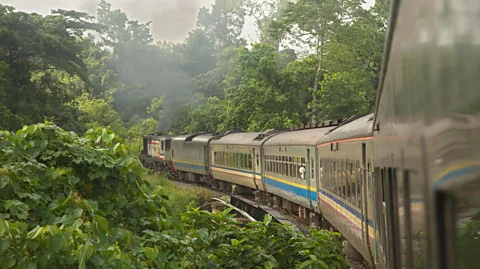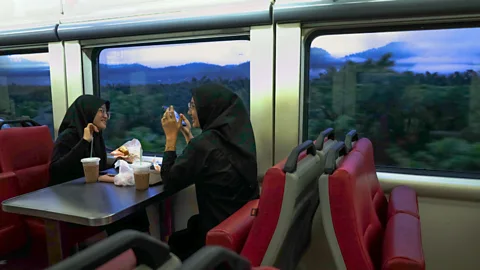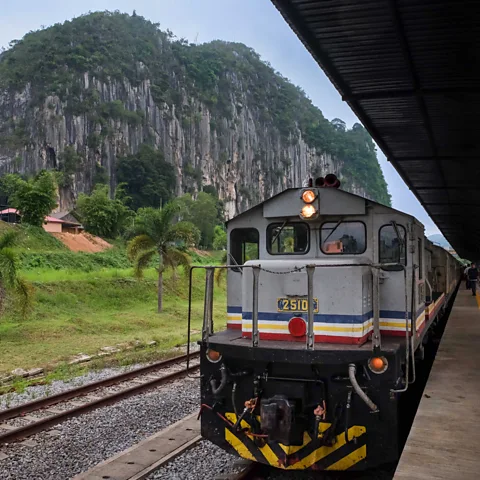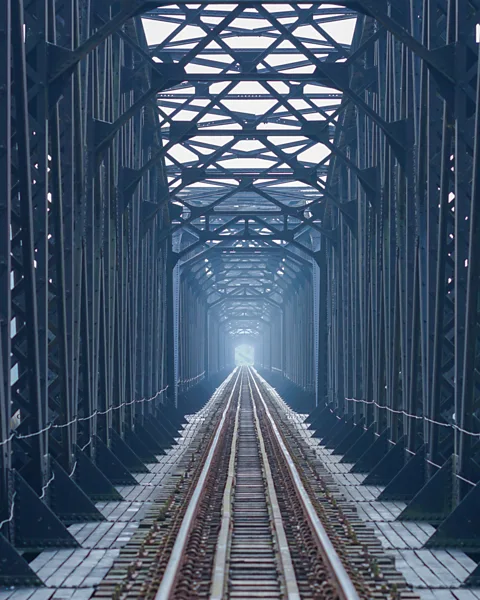25 August 2023
By Marco Ferrarese, Features correspondent
 Dorling Kindersley ltd/Alamy
Dorling Kindersley ltd/AlamyIt may soon be obsolete, but the Jungle Train is still a nostalgic jaunt across the heart of the Malay Peninsula, taking in forgotten towns steeped in colonial history.
The dawn light peered through the window of my upper berth, waking me as our carriage bolted over the rails. Outside, purple rays broke through a blanket of low-hanging clouds and thawed the condensation on the train’s windows, revealing sinuous and misty hills draped with viridian canopies. Suddenly, two walls of forest closed in, almost touching the sides of the train. I gasped, but the train kept rolling unscathed. I emerged from my berth and slid down the metal ladder, reaching for my shoes.
I was riding the Ekspres Rakyat Timuran train on Peninsular Malaysia’s East Coast Line. Despite the name, it never actually touches the coast, but rather skirts some of the world’s oldest rainforest in Malaysia’s forested interior. Because of this, the historical track is better known as the “Jungle Railway”.
The Ekspres Rakyat Timuran is Malaysia’s last remaining train using diesel-powered locomotives – a far cry from the West Coast Line’s modern and fast electric service that connects Singapore and southern Thailand in under nine hours. However, with news of a faster 665km East Coast Rail Link that will open a new route along Malaysia’s east coast (to begin by 2026), the slow Jungle Railway, which takes more than 16 hours, may soon become obsolete.
So, I purchased a one-way ticket – a lower berth costs just 56RM (about £10) – and rushed to experience one of Southeast Asia’s greatest historical train rides. For those who love slow travel, the Jungle Railway immerses you in local history, and it’s the most romantic way to reach coral-ringed islands like the Perhentians and Redang strewn off Malaysia’s north-eastern coast.
 Marco Ferrarese
Marco FerrareseThe Jungle Railway connects the southernmost tip of Malaysia’s Peninsula to the Thai border in the north-east. The best way to experience it is by starting in the city of Johor Bahru near the Singapore border and head northbound. The train leaves at 20:35, allowing you to sleep through the first section of the journey, when the train trundles through the towns of the southern plains, and wake to magnificent views of ancient rainforest in the country’s interior.
In the morning, after emerging from my berth, I headed for the restaurant car in the centre of the train, where other early birds were already sipping thick local kopi (Malaysian coffee). Young women in headscarves sat next to families and older couples, enjoying the scenery as the smell of coconut jam-smeared toast filled the air. I sat on an empty bench and looked out to see tin-roofed houses hemmed in by patches of jungle and dramatic karst rock formations zoom past the train in the tropical morning light.
Since the 19th Century, the Jungle Train had been the main lifeline through British Malaya’s interior, connecting remote rural villages with former colonial outposts like Kuala Lipis, the desolate capital of Pahang state between 1898 and 1955. The British colonial administration started building the route in 1885 to help move freight across the country, baptising the train the “Golden Blowpipe” in honour of the weapon the aboriginal Orang Asli (Malay for “original people”) used to hunt in this once-impenetrable wilderness.
 Marco Ferrarese
Marco FerrareseIt took decades before the British could lay the line’s 530km of tracks across dense primary forest while settlements grew around the different stops. The service eventually began in 1938, finally connecting Tumpat near the Thai border in Malaysia’s north-east to the town of Gemas in Negeri Sembilan.
After breakfast, the first major stop was Gua Musang in southern Kelantan, where I got off the train to scan the surroundings, noticing wooden hand-painted signs from colonial times still hanging with their arrows pointing towards the line’s two opposite ends.
“After dinner, I often walked with my family to the station to watch the passing train. We’d count the stars and wait for monkeys to come, doing nothing, and then we’d walk back,” said Ong Siou Woon, who grew up in Gua Musang, where a large limestone rock formation soars over the Jungle Line’s midway station like the shell of a giant stone turtle.
The Jungle Railway wasn’t engineered for speed. “Sometimes the trains had to stop and wait for elephants to cross, or for [fallen] logs to be removed from the tracks,” said Ong, recalling the perils of riding the train 30 years ago, when she used it to commute to school in the southernmost Johor state. Even today, the service still runs on a single shared rail track most of the way, forcing opposite trains to be timed to pass each other at certain stations.
 Syed Mohd Badril Hisham Syed Abdul Khalid
Syed Mohd Badril Hisham Syed Abdul KhalidNot long after, we passed Dabong village, where the large Ikan and Keris limestone caves (famous for the “God Light” that filters through a gap in the complex’s ceiling) and 305m-high Jelawang waterfall, one of the tallest in Peninsular Malaysia, make for an ideal stop on this long journey. Next, the track swerved to the east along the bends of the Galas River and then looped south-east, leaving the jungle-clad interior and returning to plains dotted with paddy fields, traditional Malay homes and single-files of tall coconut trees.
But the most breathtaking traverse came about an hour short of pulling into Wakaf Bharu, the line’s second-to-last station, where we rolled through the black steel walls of the historic Guillemard Bridge, a piece of historical British engineering that crosses the Kelantan River. Built in 1925, this 600m single-track truss bridge (the country’s longest railway bridge) was partly destroyed by the British during World War Two to prevent the advance of the Imperial Japanese Army that eventually managed to occupy colonial Malaya between 1941-1945. It was restored as it stands today in 1948.
The train kept on going through the plains, leaving me to marvel at the feat of building and maintaining this railway through tiger and elephant territory, and how important the Jungle Railway still is in connecting the remote settlements of the interior. Finally, with one last whistle, the diesel locomotive screeched to a halt at the diminutive Tumpat station, the northern end of the line, bringing me back to reality. Just 10km from here, the Golok River marks the Thai border.
Alighting with the few remaining passengers, I walked towards the exit and looked at the train’s old-world diesel-powered car, incredulous as to how it had managed to take us across the country. Beyond it, I could see golden Buddha statues and temples glistening in the midday sun, rather than the Islamic mosques we’d passed along the route. It would be very hard, I thought, for the new East Coast Rail link to overshadow the charms of taking a slow journey on this stalwart remnant of Malaysia’s past.
Rail Journeys is a BBC Travel series that celebrates the world’s most interesting train rides and inspires readers to travel overland.




